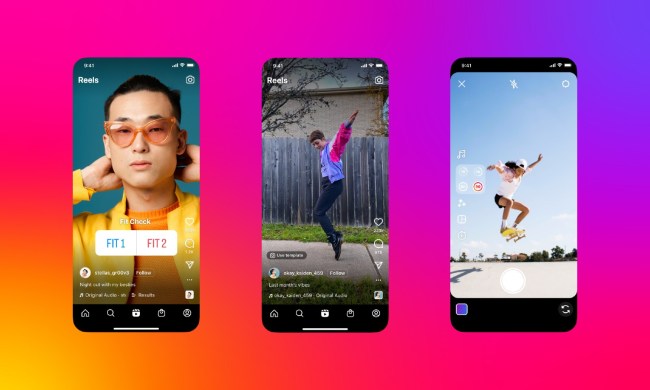When Snapchat introduced the ability to post disappearing text and media over half a decade ago, no one expected that a scruffy new startup’s headlining feature would end up consuming a row of space at the top of every other social platform in a few years. But that’s exactly what has happened.
Snapchat’s Stories has flourished into a social network staple, and now the world’s biggest tech companies are clamoring to bake this breakout format into their offerings. Today, a familiar row of avatars sits above all else on some of the most popular apps. You can now post these ephemeral “Stories” on Twitter, Facebook, Messenger, WhatsApp, Pinterest, YouTube, LinkedIn, and Google (for publishers), and possibly even Spotify in the near future.

So what gives? Why did Stories, a way for people to post a self-destructing thread of images, text, videos, and all sorts of goofy elements, emerge as the internet’s most sought-after medium of communication?
To answer that, it’s key to look back and understand what made Stories so widely adopted in the first place.
The rise and rise of Stories
Stories were originally designed as a more personal channel for sharing your intimate, “in-the-moment” experiences. Since they expire in a day, people don’t have to worry about making every detail perfect because the post won’t remain in their profile forever. It essentially leapfrogged the usual perils of actively posting online, while at the same time arming users with a load of creative tools that lowered the content barrier and enabled users to post as often and as uniquely as they want. This kind of ephemeral messaging is what made Snapchat such a breakout success in an already crowded social media landscape.
Will Francis, an independent social media expert, likens the rise of Stories to predigital social behavior. “We wanted casual chats with friends, not to print those thoughts in the local newspaper unless it was something really important,” he told Digital Trends.

This is even more evident in the announcement posts where companies outline why they adopted Stories for their apps.
“To help people feel more comfortable, we’ve been working on a lower-pressure way for people to talk about what’s happening,” wrote Twitter.
“LinkedIn Stories are a great way to start lightweight conversations related to your work/life,” noted LinkedIn in its post.
“Creating with Stories is lightweight, easy, and fun,” said YouTube.
Lightweight and low pressure. That is what sets apart Stories from pretty much everything else most of the social networks offer. Online platforms thrive on information that powers their community, but with Stories, they are willing to let go of that for more spontaneous activity.
The brainchild of the attention economy
There is a limit to how many tweets or pictures you’d be willing to publish in a day. But that limit practically doesn’t exist with Stories. As a story doesn’t permanently stay in someone’s profile, it puts these “overposting” concerns to rest — which is why many users find themselves publishing dozens of these ephemeral stories to, say, document a trip, while only pushing out a handful of permanent posts. More engagement is what an online platform ultimately wants, which in turn is ideal for their advertisers.
It’s this recipe for engagement that has made other tech companies, social or not, sit up and take note of Stories. The figures back it up as well. According to Hootsuite, a social media management platform, about half of Instagram’s monthly users use Stories — that’s 500 million people posting a billion Stories every day.

The other tech companies can’t afford to miss out on this, especially when some of them are struggling to retain engagement levels.
More importantly, the tech behind Stories itself is designed to dominate users’ attention and their ephemeral nature psychologically boosts engagement. People tend to check Stories and the platform that offers Stories itself more regularly because they don’t want to miss them before they expire — as opposed to, for instance, YouTube videos that will always be available.
Arun Lakshmanan, an associate professor of marketing at the University at Buffalo, in his ongoing research, found that once we feel that we can get the information whenever we want, we tend to lose interest.
Evan Asano, founder and CEO of Mediakix, a leading influencer marketing agency, believes Stories are also a surefire outlet for online platforms to attract and drive traffic into the other aspects of their service.
https://twitter.com/Twitter/status/1328684389388185600?s=20
“If YouTube doesn’t offer it and everyone else does, then you could see engagement and viewership shifting,” Asano said. “So audiences spend more time on Instagram because it has Stories, but also offers longform video and Reels and less time with YouTube because audiences know they can always watch their favorite content later.”
Then there’s the UI. The endless forward and backward tap design imbues us with a false sense of a reward at the end, which is what keeps us watching and coming back for more.
Alex Muench, a product designer at Doist, a productivity software maker, says that the inviting interface to create Stories is built in a way that there’s no learning curve. “It opens your camera and without much deliberation, you can simply snap a photo or record a video. This contributes to a low cognitive load, which means you don’t have to think much,” he said.
From keyboards to cameras
It’s worth noting that Stories as a format is platform-agnostic. It doesn’t demand a prerequisite trait to work. On Twitter, you can take advantage of it to react to real-time news events, post stories about your professional life on LinkedIn, share travel moments on Instagram Stories, and so on.
Therefore, we can no longer perceive Stories as a Snapchat feature that everyone’s copying. It’s the modern-day evolution of the traditional mediums of online sharing we’ve grown accustomed to, but designed specifically for the camera-first audience. Much like how several platforms began adopting livestreaming tools or an algorithmic feed a few years ago, Stories will soon become a default feature on most online platforms.
“One day, stories will be as synonymous with the web as text. Before stories, every platform was text-first,” Ash Read, head of content at Buffer, a popular social media scheduling tool. “You’d open up Twitter, LinkedIn, Facebook, and see the same prompt to start writing a post, then you could add an image to sit alongside your text, then a video. Stories are a natural evolution of this for a generation that’s grown up communicating on mobile devices.”
Of course, there’s a business angle to this for companies, and if Stories take off for them, it is, at the end of the day, another channel for broadcasting ads and generating revenue.

But the incentive to add Stories may not be as simple as it appears for a few, suggests Matt Navarra, a social media consultant. Given the format’s astronomical growth and adoption, platforms like Twitter and LinkedIn could be betting on Stories as a desperate attempt to fix their foundational roadblocks.
“I think Twitter has a problem with new users who don’t understand how to use Twitter,” he said. “So I think adding Stories or Fleets addresses some of those challenges early on for people, and it’s a format that’s really easy to grasp, seeing it for a long time.”
For LinkedIn, on the other hand, Stories are filling that absence of creative tools that has largely made the professional social network’s feed too monotonous and newsy.
“While the motivation behind Twitter and LinkedIn’s decision to adopt this format differ, what is clear is both companies set out to increase the number of time people are spending on their platforms,” Eva Taylor, Hootsuite’s director of social strategy, operations and corporate social responsibility, told Digital Trends.
The post-Stories future of social networks
So where does that leave social networks? What will differentiate them if all of them simply offer the same set of features?
Over the last few years, an increasingly common pattern has formed among various online platforms. Instead of coming up with the most innovative next feature, their focus has shifted toward equipping their own, specific audiences with the best possible tools and engineering mechanisms for a healthy community. And if that means borrowing a viral feature from a rival platform like Snapchat’s Stories, so be it.

Therefore, in the long run, Navarra reckons, the platforms that put the onus on fostering a standout personality and network of communities will be the ones that prosper, not the platforms that come up with one clever feature that can easily be reproduced in a short amount of time.
“Now, we’re seeing that it’s not the product or service that’s helping to differentiate these platforms, but it’s their audiences and specific use cases,” adds Hootsuite’s Taylor. “While we’re seeing platforms add similar features that have proven to work, we will continue to see social media platforms utilize these features in a way that best resonates with their core audience and the topics they care about.”



